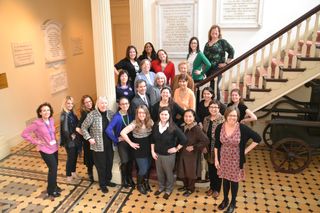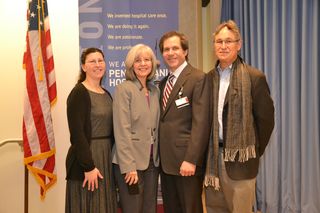In the 19th Century, rigorous work was thought to negatively affect female fertility.
It was also thought to create a masculine and angular appearance in women, thus stunting the development of femininity.
These are just a sample of some of the startling yet fascinating “facts” presented by ten distinguished speakers at the 2014 History of Women’s Health Conference held at Pennsylvania Hospital of Penn Medicine on April 2.
 Strike a pose! Presenters and guests of Pennsylvania Hospital’s 9th Annual History of Women’s Health Conference give us the “Renaissance Elbow.” Originally created by portrait painters during the Renaissance and depicting men placing a fist on their hip and jutting out their elbow to make themselves appear impressive, the pose was resurrected during the American Revolutionary War period. Primarily used in portrait art, groups of siblings were characteristically shown with prized sons posed in front – elbows out – while daughters were relegated behind them, virtually scenery. This was shown in the presentation, “The Pregnant Revolution: Women and Fertility in the New Nation” by Susan E. Clepp, PhD., professor Emerita of History, Temple University, shown here, fourth from the left.
Strike a pose! Presenters and guests of Pennsylvania Hospital’s 9th Annual History of Women’s Health Conference give us the “Renaissance Elbow.” Originally created by portrait painters during the Renaissance and depicting men placing a fist on their hip and jutting out their elbow to make themselves appear impressive, the pose was resurrected during the American Revolutionary War period. Primarily used in portrait art, groups of siblings were characteristically shown with prized sons posed in front – elbows out – while daughters were relegated behind them, virtually scenery. This was shown in the presentation, “The Pregnant Revolution: Women and Fertility in the New Nation” by Susan E. Clepp, PhD., professor Emerita of History, Temple University, shown here, fourth from the left.
This was the hospital’s ninth annual History of Women’s Health conference. Free and open to the public, the Conference focuses on areas of women’s health from the 18th century to the present. It began as a part of Pennsylvania Hospital’s celebration of co-founder Benjamin Franklin’s tercentenary – what would have been his 300th birthday. Each year since, scholars from the humanities and health care professionals gather to discuss the past, present, and future state of women’s health at this lively forum co-sponsored by the Pennsylvania Hospital Historic Collections, the Department of Obstetrics and Gynecology, and Hospital Professional Staff.
“The typical audience for this conference is a mix of physician and nursing professionals, community members, history enthusiasts, and professionals in history and the humanities,” said Stacey Peeples, curator and lead archivist at Pennsylvania Hospital. “We host the conference each year to create a forum for open discussion of women’s health through a variety of perspectives – historical and modern – by taking an interdisciplinary approach. We celebrate the fact that Pennsylvania Hospital has always been a leader in women’s health, a leader in open discussions about where we’ve been, where we are, and where we might be going.”

Shown here from L to R are: Stacey C Peeples, curator-lead archivist, Wanda Ronner, MD, professor of Clinical Obstetrics and Gynecology, Peter Gearhart, MD, clinical assistant professor of Obstetrics and Gynecology, Pennsylvania Hospital, and conference keynote speaker Robert Aronowitz, MD, professor and chair, History and Sociology of Science, University Pennsylvania.
From women struggling to enter into the predominantly male field of medicine to the female medical research subject, women throughout history were misunderstood, misrepresented, and misaligned. As Dr. Carol-Ann Farkas described in her presentation at the conference (more about that later) even brilliant women who were trailblazers in their field were constantly evaluated and judged and if “praised” – it was with the equivalent impact of the proverbial “left-handed compliment.” If a female physician was reviewed (by males, of course) it could not be done without comment on how attractive, feminine, and graceful she also was. The message is clear. Historically, intellect and achievement, particularly in the field of medicine, were not imagined or accepted female attributes. If a pretty, smart, female physician was acknowledged, she was a novelty to be admired mainly for curiosity’s sake, not for her accomplishments.
A presentation from Carrie Adkins, PhD, an instructor at the University of Oregon, about Catharine Macfarlane demonstrated this dichotomy perfectly. Macfarlane, who lived from 1877 to 1969, is an historical figured we can celebrate with local pride. A graduate of the University of Pennsylvania and the Women’s Medical College of Philadelphia (MCP), who became a research professor and professor of Gynecology at MCP. Macfarlane was the first physician in the Philadelphia area to use radium in the treatment of cancer, the first woman president of the Obstetrical Society of Philadelphia, the founding member of the American Academy of Obstetrics and Gynecology, and the first woman member of the Philadelphia College of Physicians. The American Medical Associations’ Committee on Clinical Research awarded Macfarlane a grant to establish the first cancer-prevention research clinic in Philadelphia. In 1951, she was jointly awarded (along with another female physician, Elise L’Esperance) the prestigious Albert Lasker Clinical Medical Research Award for pioneering work in developing cancer detection clinics for the discovery of early cancer of precancerous lesions in presumably healthy people. MacFarlane was even the featured guest in a 1956 episode of the popular TV show, “This is Your Life.”
A skilled surgeon, beloved teacher, and public women’s advocate, Macfarlane’s accomplishments are too many to mention here. According to Adkins, despite all this, how her life’s work were viewed by most in the medical community during her time can be summed up by two of the gifts she was awarded simultaneously at the height of her career: an advanced OR surgical lamp – one of only seven available in the U.S. at the time – and a triple strand pearl necklace. Hence the title of this post, and the title of Adkins’ talk: “Technology and pearls.”
Carol-Ann Farkas, PhD, associate professor of History/Women’s Studies MCPHS University, gave a particularly “entertaining” presentation, “Constructing the ‘Lady Doctor’: Femininity and Female Professionalization in the Popular Press of the Late Nineteenth-Century.” I say it was entertaining because of the compelling factoids Farkas shared from the 19th Century, including the two at the beginning of this post:
Women were unable to pursue careers in medicine because they were viewed as “nothing but a bundle of nerves.”
- Women were too delicate to withstand the study of gross anatomy (Gee professor, how can I ever dissect if I keep passing out?).
- If women were recognized as good surgeons, it was only because they were “required to do so much needle work.”
- The “mind” (i.e. academic intelligence) was “an enemy to beauty.”
Despite all this, there were 430 female medical school graduates in the U.S. in 1881. Sadly though, most of these women were viewed as “veragos” – a word that literally comes from the Latin “vir”, meaning “man.” Look up the meaning of veragos today and it either means a loud, angry woman or a large, strong, courageous women. This particular presentation brought about lots of laughter from Conference attendees. “People laugh and giggle at all this, but how depressing that’s how it really was,” summed up Fargas.
“From Nuns to Natives: The Postcolonial History of the Cytopipette”, by Jennifer Fraser, a PhD candidate from the University of Toronto, was another fascinating presentation. Historically there have been huge discrepancies between the aboriginal, Inuit communities of Canada compared to the Canadian average when it comes to cervical cancer. From 1989-2003, cervical cancer rates among Inuit communities was three times higher than other Canadian women, and from 1976-1990, Inuit women had a 30 percent lower participation in pap test screening compared to their Canadian counterparts. Today we better understand the challenges of socioeconomic differences and access to health care in conducting clinical research. But this wasn’t the case in the past.
In 1960, 600 Inuit women were screened for cancer using a self-testing device. The women were literally rounded up onto a ship (you read correctly) to receive the “cytopipette” with little explanation or instruction. If cancer was found in any of these patients who somehow managed to correctly obtain a lab specimen from themselves, well…participants weren’t even identified in this particular study. So, if cancer was found, they were not informed or treated. Could you imagine such unethical practices today?
What is intriguing about this and other research at the time comparing cervical cancer rates between Inuit women and Canadian nuns, is how, despite despicably poor study designs, an early germ connection between HPV virus and cervical cancer was made. Decades before this connection was fully understood, cervical cancer among Canadian nuns was shown to be non-existent. Sadly, the same could not be found among Inuit women. Their higher than national average cervical cancer rates were chalked up to being due to, “early promiscuity and poor genital hygiene.”
It’s easy for us now to examine the past and see how so much was so wrong on so many levels in the history of women’s health. As the expression goes, hindsight is always 20/20. Thankfully, today’s researchers and clinicians can learn from the past. “Studying the evolution of women’s health care makes us better clinicians,” said Peter Gearhart, MD, clinical assistant professor of Obstetrics and Gynecology at Pennsylvania Hospital, who emceed the conference. “By understanding the way our profession has evolved and how our past treatment decisions have impacted women and their families, we are able to incorporate new technological advances in a more humanistic way.”